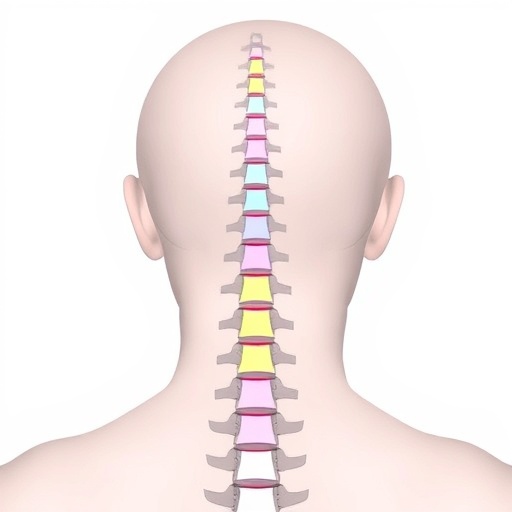In a groundbreaking advancement poised to reshape the landscape of spinal cord injury (SCI) treatment, an international team of researchers has developed a novel neurostimulation implant capable of precisely stabilizing blood pressure—a critical physiological parameter often compromised in individuals with SCI. This cutting-edge technology promises not only to improve immediate quality of life but also to mitigate long-term cardiovascular risks for patients who have suffered devastating neurological trauma.
Cody Krebs, a 32-year-old who endured a severe spinal cord injury following a motor vehicle accident in 2022, embodies the transformative potential of this innovation. Prior to receiving the implant, Krebs grappled daily with dramatic fluctuations in his blood pressure, oscillating between sudden dangerous drops that risked inducing loss of consciousness and extreme spikes that heightened his likelihood of heart attack or stroke. His lived experience highlights a critical yet under-addressed facet of SCI: autonomic dysregulation of cardiovascular function, which has often been overshadowed by efforts focusing predominantly on restoring motor function.
The research, spearheaded by multidisciplinary teams from the University of Calgary, École Polytechnique Fédérale de Lausanne (EPFL), the University of Lausanne (UNIL) in Switzerland, and medical centers in the Netherlands, was published simultaneously in the revered journals Nature and Nature Medicine. These landmark studies delineate not only the physiological challenges faced by SCI patients but also reveal comprehensive neuronal mapping of the spinal cord circuits responsible for autonomic dysreflexia—a potentially fatal condition characterized by unchecked, life-threatening elevations in blood pressure.
Central to this breakthrough is the development of an implantable spinal neurostimulation system composed of specialized electrode arrays strategically positioned along the spinal cord. These electrodes interface with a custom-designed pulse generator akin to a cardiac pacemaker, delivering targeted electrical impulses that modulate the complex neuronal architecture controlling blood pressure. Importantly, the stimulation parameters are individually calibrated, allowing personalized therapy that adapts dynamically to each patient’s specific autonomic profile.
This implantable system leverages recent advances in neuroscience and biomedical engineering to achieve real-time neuromodulation. By finely tuning the patterned electrical stimuli, the device effectively competes with pathological sympathetic overactivity that drives blood pressure aberrations after SCI. In clinical trials spanning Canada, Switzerland, and the Netherlands, participants experienced rapid normalization of blood pressure within minutes of activating the device, underscoring the therapy’s efficacy and immediate impact.
Aaron Phillips, PhD, director of the RESTORE Network and associate professor at the Cumming School of Medicine at the University of Calgary, emphasized the translational significance of these findings. He noted that this research elegantly bridges the foundational science of neuronal circuit mapping with practical clinical application—facilitating an unprecedented acceleration from laboratory discovery to therapeutic implementation. The studies jointly demonstrate not only the severity of chronic hypotension and hypertensive spikes post-SCI but also validate the neuromodulation approach across diverse healthcare settings and protocols internationally.
Long-term, the chronic instability of blood pressure in SCI patients can exact a profound toll. Persistent low blood pressure leads to chronic fatigue, diminished cognitive acuity, and heightened fainting risk, while extreme hypertensive episodes precipitate strokes and myocardial infarctions. By deploying this novel neuromodulation therapy, researchers have shown durable regulation that prevents these deleterious cardiovascular events, thus offering a paradigm shift in managing autonomic complications of SCI beyond symptomatic treatment.
The detailed neuronal architecture characterized in the Nature publication reveals the specific spinal networks orchestrating autonomic dysreflexia. This understanding enables precise stimulation strategies that modulate rather than suppress neuronal activity, preserving physiological adaptability while preventing dangerous blood pressure surges. Grégoire Courtine, PhD, director of the NeuroRestore Center and EPFL professor, describes this approach as a sophisticated interplay between device-guided electrical input and the host’s neurophysiology to restore homeostasis.
Clinicians employing the implant observed rapid improvements extending beyond blood pressure stabilization. Patients reported enhanced mental clarity, reduced brain fog, increased energy levels, and better tolerance to post-meal blood pressure dips. Neurosurgeon Ilse van Nes, MD, PhD, who facilitated implant surgeries and follow-ups at Sint Maartenskliniek Rehabilitation Center in Nijmegen, highlighted the system’s ease of use in everyday settings, indicating strong potential for widespread clinical adoption.
Neurosurgeon Jocelyne Bloch of Lausanne University Hospital noted the international clinical deployment’s success as a pivotal milestone toward global accessibility. The implant’s surgical procedure demonstrates safety and reproducibility across different health systems—a critical consideration for scalability. Furthermore, Dr. Fady Girgis from the Foothills Medical Centre affirmed the robust safety profile of the implantable device, given its established use in pain management, enabling a seamless transition to this novel indication for blood pressure control.
Patient testimonials affirm the profound personal impact of this therapy. Krebs expressed renewed confidence and gratitude, emphasizing his regained ability to control blood pressure fluctuations, experience heightened mental functioning, and reduce risk of harmful spikes. These qualitative benefits reflect meaningful improvements in daily living, psychosocial well-being, and long-term health prospects.
The implantable neurostimulation platform originates from the neurotechnology company ONWARD Medical, which recently received FDA approval to launch a pivotal trial expanding participation to approximately 20 leading neurorehabilitation and neurosurgical centers across North America and Europe. This next phase aims to validate the therapy’s efficacy and safety in broader, more diverse patient populations—potentially establishing a new standard of care for autonomic dysregulation in SCI.
This novel neurostimulation technology exemplifies the synergy of interdisciplinary innovation, integrating neuroscientific discovery, engineering prowess, and clinical expertise. It highlights the remarkable potential to harness targeted electrical modulation for restoring complex autonomic functions lost to spinal cord injury, addressing a critical unmet medical need that affects millions worldwide. As this therapy advances through clinical phases, it holds promise not only for SCI patients but also for broader applications in treating dysautonomic conditions characterized by vascular instability.
In conclusion, the development and clinical translation of this neurostimulation implant represent a transformative leap forward in managing spinal cord injury’s autonomic sequelae. By illuminating the intricate spinal cord circuitry behind blood pressure dysregulation and harnessing it through an adaptable, patient-specific implant, the researchers have charted new territory in personalized neuromodulation therapies. This innovation stands to dramatically improve functional independence, reduce cardiovascular morbidity, and enhance quality of life for people navigating the challenges of a life-altering injury.
Subject of Research: People
Article Title: A neuronal architecture underlying autonomic dysreflexia
News Publication Date: 17-Sep-2025
Web References: http://dx.doi.org/10.1038/s41586-025-09487-w
Image Credits: University of Calgary
Keywords: Blood pressure, Medical technology, Medical treatments, Nerve injuries, Spinal cord injuries
Tags: advancements in SCI rehabilitationautonomic dysregulation and cardiovascular functionblood pressure management for SCI patientsblood pressure regulation in SCICody Krebs spinal cord injury caseimproving quality of life after spinal injuryinnovative medical devices for neurological traumainternational collaboration in medical researchlong-term cardiovascular risks after SCImultidisciplinary research in neurologyneurostimulation implant technologyspinal cord injury treatment





